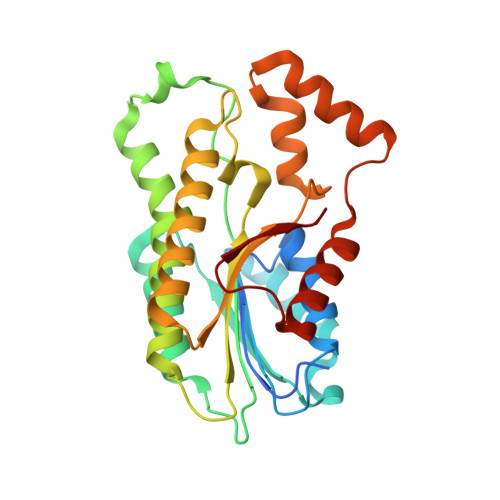Reduction of Neuropathic and Inflammatory Pain through Inhibition of the Tetrahydrobiopterin Pathway.
Latremoliere, A., Latini, A., Andrews, N., Cronin, S.J., Fujita, M., Gorska, K., Hovius, R., Romero, C., Chuaiphichai, S., Painter, M., Miracca, G., Babaniyi, O., Remor, A.P., Duong, K., Riva, P., Barrett, L.B., Ferreiros, N., Naylor, A., Penninger, J.M., Tegeder, I., Zhong, J., Blagg, J., Channon, K.M., Johnsson, K., Costigan, M., Woolf, C.J.(2015) Neuron 86: 1393-1406
- PubMed: 26087165
- DOI: https://doi.org/10.1016/j.neuron.2015.05.033
- Primary Citation of Related Structures:
4XWY - PubMed Abstract:
Human genetic studies have revealed an association between GTP cyclohydrolase 1 polymorphisms, which decrease tetrahydrobiopterin (BH4) levels, and reduced pain in patients. We now show that excessive BH4 is produced in mice by both axotomized sensory neurons and macrophages infiltrating damaged nerves and inflamed tissue. Constitutive BH4 overproduction in sensory neurons increases pain sensitivity, whereas blocking BH4 production only in these cells reduces nerve injury-induced hypersensitivity without affecting nociceptive pain. To minimize risk of side effects, we targeted sepiapterin reductase (SPR), whose blockade allows minimal BH4 production through the BH4 salvage pathways. Using a structure-based design, we developed a potent SPR inhibitor and show that it reduces pain hypersensitivity effectively with a concomitant decrease in BH4 levels in target tissues, acting both on sensory neurons and macrophages, with no development of tolerance or adverse effects. Finally, we demonstrate that sepiapterin accumulation is a sensitive biomarker for SPR inhibition in vivo.
Organizational Affiliation:
Kirby Neurobiology Center, Boston Children's Hospital and Department of Neurobiology, Harvard Medical School, Boston, MA 02115, USA.

















